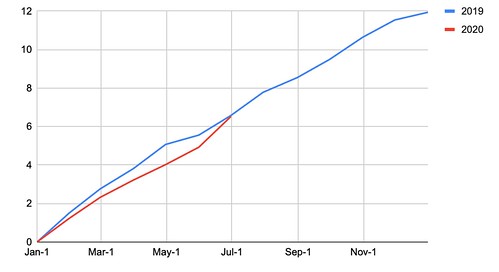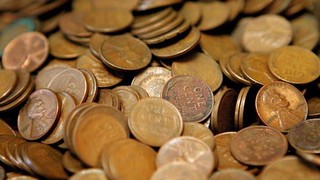
PREV ARTICLE
NEXT ARTICLE
FULL ISSUE
PREV FULL ISSUE
MORE ON THE COVID-19 COIN SHORTAGEHere are a few recent articles on the current coin shortage. I haven't seen this much in my area (Northern Virginia), but I don't get out much. -Editor
"Right now I have no pennies," said Nabi Hossain, a manager at City Bakery Café. "The owner, when he went to the bank to get more pennies, he could only get one roll from the bank." Her café is hardly alone. Corner stores, restaurants, and gas stations across Denver are reminding patrons that exact change may not be possible. Pennies and nickels are hard to come by at the bank. The impact is most felt in businesses that still use cash, like small restaurants and thrift stores. But with many payments going touchless, others hardly notice the change.
To read the complete article, see:
The think tank Cato Institute published a paper on the coin shortage. Here's an excerpt. -Editor No doubt many find the idea of a coin shortage perplexing. Coins are not consumed; they get passed along from one person to another. In the US, the average coin circulates for around 30 years. How, then, can there suddenly be a shortage of coins? Where have they all gone? Each year, some coins are lost, discarded, or worn beyond use. They get thrown in a well with a wish; or, dropped down a drain by mistake. To offset the outflow, and keep up with secular growth in demand, the Mint must produce new coins. It issued nearly 12 billion circulating coins in 2019. 
Source: This graph is based on data collected by the author from multiple data tables on Coin?News?.net and USMint?.gov. So far, the Mint has not matched its 2019 pace. The global pandemic slowed production at the Denver and Philadelphia branches in March and April. By the beginning of May, the cumulative mintage—that is, the total number of circulating coins produced for the year—was just 4.02 billion, compared with 5.07 billion over the same period in 2019. Both facilities have been operating at full capacity since June 15, though, so that the gap has since fallen to less than 0.06 billion. But the temporary shortfall in production is only a small part of the problem. A much bigger issue has been the limited extent to which coins have been circulating. Coins have a much higher weight-?to-?value ratio than cash, which makes them relatively cumbersome to use. Cash goes into wallets, ready to make the next transaction. Coins go into piggy banks, to be deposited or exchanged for cash only occasionally. Usually, the vast stockpile of coins held by the public is of little consequence because it represents a roughly steady share of the total coin supply. Sure, paper currency circulates more quickly. But peoples' depositing or exchanging coins when their piggy banks get full also results in a relatively steady flow of coins back into the banking system. Alas, not much has been as usual in the last few months. The global pandemic and corresponding shutdowns have led to a huge slowdown in economic activity. Consequently, the usual flow of coins from our piggy banks into the banking system has dried up. Of course, the flow from the banking system to our piggy banks also dried up, as retailers did not need to request coins from their banks to make change for non-?existent customers. But as the economy reopened, stores quickly exhausted their existing coin inventories, and then turned to their banks for more. The flow of coins out of the banking system picked up, as coins started piling up in our piggy banks once more. But the flow of coins back into the banking system, from our piggy banks, had not yet restarted. Lacking the usual coin deposits from the public, the banks, in turn, requested coins from the Fed, which requested them from the Mint. With the Mint unable to fill the gap with new coins—and, indeed, falling short of its usual production levels—-a shortage resulted. The paper goes on to state that "policy decisions have made the shortage much worse than necessary," discussing the continued minting of cents and the historical competition from private mints fulfilling demand when the government fell short. -Editor The costs of a coin shortage are probably lower today than in the past. We are fortunate to have many alternative payment options. Nonetheless, we should acknowledge the weaknesses of our current system and make improvements if possible. At a minimum, that means scrapping the penny. More fundamental reforms, like permitting competition in coinage, would be better still. Reviving private coinage is an interesting possibility, but not one endorsed by governments around the world, nor anything being demanded by citizens. In normal times the Mint supplies everything needed, with the usually unwanted cents as a bonus. -Editor
To read the complete article, see:
See the Coin World article linked below for a statement from the U.S. Mint. Here's an excerpt on Federal Reserve coin distribution. -Editor The Federal Reserve often shifts circulating coin inventories between contracted armored carrier terminals to alleviate regional shortages, but officials indicate the COVID-19 pandemic presents different challenges. A temporary coin order allocation at all Federal Reserve Bank offices and Federal Reserve coin distribution locations was imposed by the Fed June 15. “The COVID-19 pandemic has significantly disrupted the supply chain and normal circulation patterns for U.S. coin,” according to FRBservices.org. “In the past few months, coin deposits from depository institutions to the Federal Reserve have declined significantly and the U.S. Mint's production of coin also decreased due to measures put in place to protect its employees. “Federal Reserve coin orders from depository institutions have begun to increase as regions reopen, resulting in the Federal Reserve's coin inventory being reduced to below normal levels.
To read the complete article, see:
Supermarket chain Kroger has come up with a handy solution. -Editor Kroger spokesperson Erin Rofles confirmed Friday the grocer will no longer return coin change to customers. Instead, the remainders from cash transactions will be applied to customers' loyalty cards and automatically used on their next purchase. Customers are also encouraged to 'Round Up' to support the company's Zero Hunger/Zero Waster Foundation. The upshot? If you go to Kroger, for now you can forget your change purse.
To read the complete article, see:
For a nice synopsis of events from Snopes, see:
To read the earlier E-Sylum articles, see:

Wayne Homren, Editor The Numismatic Bibliomania Society is a non-profit organization promoting numismatic literature. See our web site at coinbooks.org. To submit items for publication in The E-Sylum, write to the Editor at this address: whomren@gmail.com To subscribe go to: https://my.binhost.com/lists/listinfo/esylum All Rights Reserved. NBS Home Page Contact the NBS webmaster 
|
